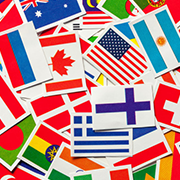General subject related
In 2024, U.S. ecommerce hit $1.192 trillion, with over 80% of Americans shopping online. Most online purchases are physical goods that are taxable, which means retailers must know the correct sales tax rates to charge based on where the buyer is.
There are over 13,000 tax jurisdictions in the U.S., each with its own rules. What makes it trickier is that different states use different sourcing rules to decide which rate applies.
How is Sales Tax determined?
- For most online sales: Tax is based on the shipping address (this is called destination sourcing),
- Sometimes: Tax is based on the seller’s address (known as origin sourcing), but only in some states and for certain in-state sales like store pickups or deliveries,
- Rarely: Tax is based on the billing address, usually only when no shipping address is available, like with digital products.
Examples of state rules:
- Ohio: Uses the location where the order was received for in-state internet sales,
- Illinois: Uses destination sourcing for out-of-state orders and origin sourcing for in-state ones,
- Texas: Tax is based on where the sale is “consummated”, either where the order was taken or fulfilled,
- Virginia: In-state sellers use their business address; out-of-state sellers use the delivery address.
What about shipping fees?
Whether shipping charges are taxable depends on:
- The state,
- Whether the goods shipped are taxable,
- If the shipping fee is listed separately on the invoice.
In general, when shipping charges are applied to taxable items, those charges are also subject to sales tax.
Online retailers with sales across multiple states must apply the appropriate sales tax rate according to each state's rules. With thousands of tax jurisdictions in the U.S., compliance can be complex, but it is crucial for businesses that have a sales tax nexus, established through physical presence or economic activity in a state.
Other news from Other countries
South Africa Proposes Major VAT Reforms to Modernize Tax System
 Other countries
Author: Ljubica Blagojević
Other countries
Author: Ljubica Blagojević
South Africa’s 2025 draft TLAB and TALAB propose major VAT reforms to modernise the system and close compliance gaps. Key changes include extending intermediary rules to local suppliers, zero-rating silver exports and clinical trial services, exempting all basic education supplies (forcing some schools to deregister), removing low-value import thresholds, and tightening VAT registration with site... Read more



Québec's Electronic Invoicing and Tax Reporting System
 Other countries
Author: Ljubica Blagojević
Other countries
Author: Ljubica Blagojević
In Québec, all receipts are treated as invoices and must be issued through certified sales recording systems (SRS), with data transmitted in real time to Revenu Québec via WEB-SRM. Required customer documents include invoices, credit notes, and reprints, while quotes and temporary bills are optional. Receipts must be in French only and contain detailed business, tax, and transaction data along wit... Read more



Brazil Unifies Tax System with Dual-VAT Reform and New E-Invoice Mandate
 Other countries
Author: Ljubica Blagojević
Other countries
Author: Ljubica Blagojević
Brazil has approved a sweeping consumption tax reform, replacing its fragmented system of ISS, ICMS, PIS, and Cofins with a dual-VAT model: the IBS (subnational) and the CBS (federal). Enacted through Constitutional Amendment 132/2023 and Supplementary Law 214/2025, the reform will be phased in from 2026 to 2032. It also introduces a federally managed unified electronic invoice, replacing multiple... Read more



Australia’s e-Invoicing Mandate: A Concise Overview
 Other countries
Author: Ema Stamenković
Other countries
Author: Ema Stamenković
The Australian government plans to make e-invoicing the default method for exchanging invoice information with Commonwealth government agencies by mid-2026. By December 2026, agencies must enable automated e-invoicing and meet clear adoption deadlines. E-invoices now meet tax invoice requirements in Australia, providing certainty for businesses adopting digital invoicing. Full e-invoicing adoption... Read more



USA: Simplified Sales Tax (SST) Program: Pros and Cons for E-commerce
 Other countries
Author: Ljubica Blagojević
Other countries
Author: Ljubica Blagojević
The Simplified Sales Tax (SST) program, adopted by 24 states, aims to simplify sales tax administration for remote sellers. It features centralized registration, free compliance for volunteers, and audit protection. However, it requires registration in all 24 states and sacrifices vendor discounts. SST may not be suitable for businesses with nexus in few states or those seeking vendor discounts or... Read more



UAE E-Invoicing Mandate: Preparing for July 2026
 Other countries
Author: Ema Stamenković
Other countries
Author: Ema Stamenković
The UAE mandates e-invoicing for VAT-registered businesses starting July 1, 2026, with a phased rollout, possibly in four stages, prioritizing larger companies. Accredited service providers must validate invoices, transmit them, and report to the FTA instantly. The UAE will mandate e-invoicing for all VAT-registered businesses starting July 1, 2026, with a phased rollout, possibly in four stages,... Read more



New Zealand B2G E-Invoicing Rules for 2026
 Other countries
Author: Ema Stamenković
Other countries
Author: Ema Stamenković
The New Zealand government has mandated electronic invoicing for public agencies starting January 1, 2026. This mandate applies to domestic trade credit invoices, aiming to enhance public spending efficiency and transparency. The e-invoicing infrastructure is Peppol Network. The New Zealand government has updated its Procurement Rules, mandating electronic invoicing for public agencies under Rule... Read more


